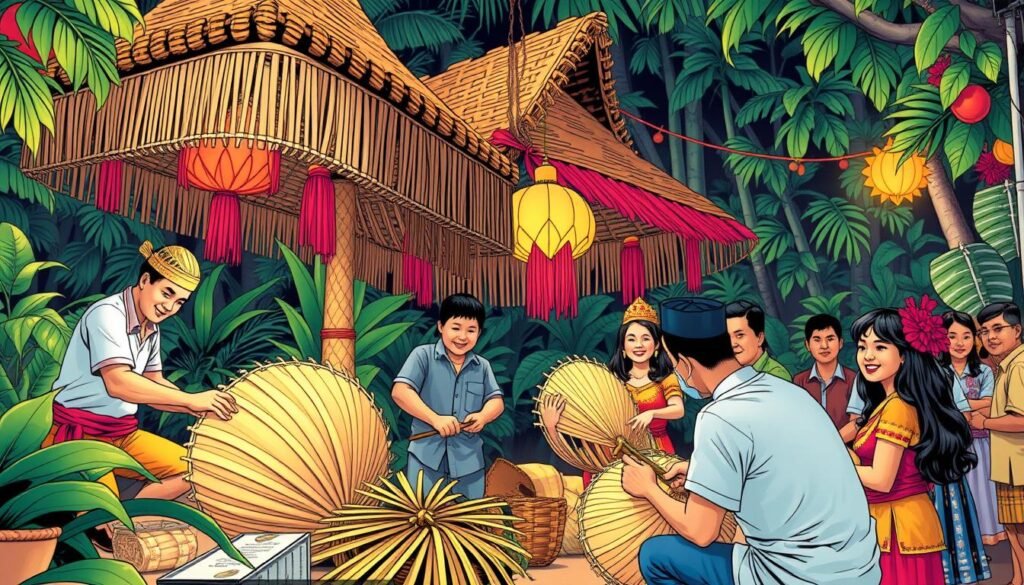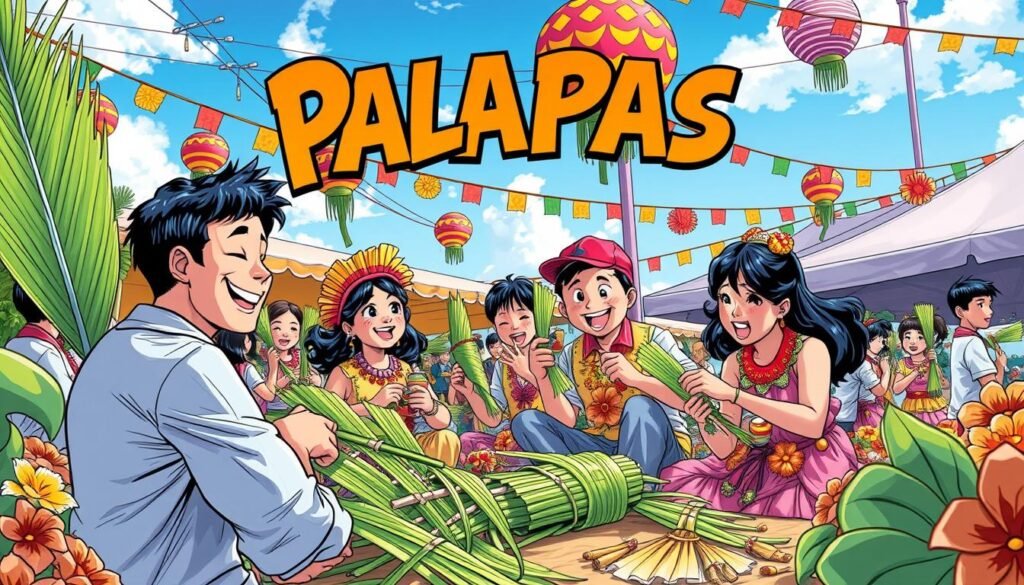What is the significance of palaspas in Filipino culture, and how does it relate to Palm Sunday? The palaspas, a traditional Filipino craft, is more than just a decoration. It stands for peace, victory, and humility. These values are deeply rooted in Filipino culture and tradition.
The tradition of palaspas dates back to early Christianity. It symbolized victory over spiritual enemies. In the Philippines, people prepare palaspas a day or two before Palm Sunday. The ashes from burnt palaspas are used on Ash Wednesday, starting the 40-day Lenten Season.
The palaspas is a key symbol in Filipino culture. It represents peace, victory, and humility. Its importance goes beyond Palm Sunday celebrations.
Key Takeaways
- The palaspas is a traditional Filipino craft made from palm leaves that symbolizes peace, victory, and humility.
- The use of palaspas has its roots in early Christianity, where it symbolized victory over spiritual enemies.
- Palm Sunday marks the beginning of Holy Week, which lasts for 7 days, and is a significant event in the Filipino tradition.
- The preparation of palaspas occurs 1-2 days before Palm Sunday, and the ashes collected from burnt palaspas are used during Ash Wednesday.
- The palaspas is a significant symbol in Filipino culture, representing peace, victory, and humility, and its significance extends beyond its role in Palm Sunday celebrations.
- The tradition of palaspas is an important part of Filipino culture and is celebrated during Palm Sunday, which is a significant event in the Filipino tradition.
- The palaspas is a symbol of Filipino artistry, with an emphasis on creativity and dexterity in the weaving and crafting process.
Understanding the Palaspas and Its Significance
The palaspas is a key tradition in Filipino culture, seen a lot during Palm Sunday. Elmer Nocheseda, a Palaspas scholar, says it started when Filipinos noticed the beauty of palm fronds. This tradition is important in the country’s religion, showing Jesus Christ’s triumphant entry into Jerusalem.
Palm leaves hold a special place in Filipino society, shown during Palm Sunday celebrations. People wave palaspas during mass, welcoming Christ like in the Bible. This tradition has been kept alive for many years, with many Filipinos joining in and buying palaspas from local weavers.
The palaspas is more than just a religious symbol. It also shows the artistic talent and creativity of Filipinos. Palaspas were used for things like rice pouches and decorations. Weaving them is a way to show devotion, with many made for religious and practical uses.
| Palaspas Tradition | Significance |
|---|---|
| Palm Sunday Celebrations | Symbolizes the triumphant entry of Jesus Christ into Jerusalem |
| Religious Devotion | Expresses deep devotion and faith |
| Artistic Expression | Showcases the inherent artistic talent and creativity of Filipinos |
The Role of Palaspas in Religious Celebrations
Palaspas plays a big role in religious celebrations, mainly in the Catholic tradition. It’s a key part of Palm Sunday in the Philippines. This shows how important this celebration is in the country.
In the Philippines, people weave palm fronds into shapes called palaspas. These are then blessed in church. This tradition shows the country’s deep Catholic roots. The palaspas symbolizes Jesus’ arrival in Gethsemane, tying it to religion and tradition.
Use in Palm Sunday Observances
Palm Sunday is the Sunday before Easter. It starts Holy Week. In the Philippines, people buy palaspas to celebrate Palm Sunday. San Juan in Ilocos Sur is famous for its palaspas weavers.

Symbolism in Catholic and Protestant Practices
Palaspas symbolizes faith, creativity, and tradition in Filipino society. Its use in Palm Sunday is a big part of Filipino religion. It shows the country’s strong Catholic tradition.
| Palm Sunday Traditions | Country |
|---|---|
| Palm fronds are intricately woven into shapes called palaspas | Philippines |
| Artificial palm leaves can exceed 30 meters in height | Poland |
| Pussy willows are used instead of palm leaves | Latvia |
The Symbolism of the Palaspas Leaf
The Palaspas leaf holds deep meaning in Filipino culture. It stands for peace, victory, and humility. Elmer Nocheseda says it’s a powerful symbol of these values in Filipino tradition. It’s also a key part of Palm Sunday celebrations in the Philippines.
The Palaspas tradition shows the country’s rich heritage and artistic flair. It highlights the Filipino people’s faith and creativity. The Palaspas leaf symbolizes peace, victory, and humility, showing the importance of being simple.
- Use of palm leaves to create detailed designs and patterns
- Significance of the Palaspas leaf in Filipino culture and tradition
- Association of the Palaspas leaf with peace, victory, and humility
The Palaspas tradition is a vital part of Filipino heritage. Its beauty goes beyond looks. It shows the Filipino people’s strong faith and creativity.
| Aspect | Significance |
|---|---|
| Peace | Represents the importance of peace in Filipino culture |
| Victory | Symbolizes the triumph of good over evil |
| Humility | Emphasizes the importance of humility and simplicity in Filipino tradition |
The Tradition of Woven Palaspas
The tradition of woven palaspas is a big part of Filipino culture, seen a lot during Palm Sunday. This religion is very important to Filipinos, and the palaspas symbolizes their faith. Now, a palaspas costs about $1, showing how the pandemic has affected vendors.
People like Pacita Andres have been getting ready for more sales after churches reopened. Selling palaspas on Palm Sunday can make more money than jobs in business outsourcing. Carmela Carandang, for example, can make 100 to 150 palm fronds a day, showing how much people want these crafts.

Woven palaspas have been around for a long time, showing their deep cultural value in the Philippines. Vendors like Arlene Rizaldo and Lorena Batusin have spent their lives making these crafts. Lorena even travels 12 hours from Laguna to Baguio to sell her palaspas. Prices range from $0.60 to $1, depending on the design, showing the variety and skill in these items.
| Palaspas Maker | Number of Palaspas Made | Daily Earnings |
|---|---|---|
| Carmela Carandang | 100-150 | $100-$150 |
| Arlene Rizaldo | 300 | $90 |
The tradition of woven palaspas is a big part of Filipino culture. It’s not just about looks; it’s about the country’s rich heritage and the role of tradition in Filipino life.
Regional Variations of Palaspas
The tradition of Palaspas varies across the Philippines. Different regions have their own practices and designs. Elmer Nocheseda notes that each area uses unique designs and patterns.
In the Catholic religion, Palaspas is key during Palm Sunday. Weaving palm leaves is a beloved part of Filipino culture. Each region has its own style and technique.

In Bulacan, people make “puni” or woven palm leaves. These are used for decorations and awards. This shows the country’s rich cultural heritage and the role of religion in Filipino life.
The different Palaspas styles show the country’s history and cultural exchange. Over time, various influences have shaped the tradition. Today, Palaspas is a big part of Filipino identity, showing the country’s strong tradition and Catholic faith.
The Palaspas in Folklore and Mythology
The Palaspas is a key part of Filipino folklore and mythology. It shows the country’s rich cultural heritage. The National Museum of the Philippines says the Palaspas is vital during Palm Sunday.
In Filipino stories, the Palaspas is linked to palm leaves. For instance, the anting-anting, or Philippine amulet, is believed to have spiritual powers. It protects the wearer from harm. The Palaspas is also used in traditional practices, like oraciones, or prayers, to make the anting-anting more effective.

The Palaspas is also a big symbol in Filipino festivals, like during Lent. The Siete Palabras, or Seven Last Words, sermons happen on Good Friday. The Palaspas is used to keep evil spirits and bad luck away. This shows the country’s deep Catholic faith and rich culture.
| Traditional Practice | Significance |
|---|---|
| Using Palaspas during Palm Sunday | Symbolizes peace and victory |
| Reciting oraciones | Enhances the effectiveness of anting-anting |
| Participating in Siete Palabras sermons | Reflects the country’s strong Catholic faith |
In conclusion, the Palaspas is very important in Filipino folklore and mythology. It shows the country’s rich culture and strong Catholic faith. Its role in traditions and festivals like Palm Sunday and Lent highlights its importance in the country’s identity.
Environmental and Economic Aspects of Palaspas
The making of palaspas affects the environment and economy. Elmer Nocheseda says it’s important to get palm leaves sustainably. The use of palm leaves in palaspas is a big part of religion, like in the Catholic faith.
Palaspas production brings in a lot of money, with millions of pesos from coconut trees each year. But, it also harms the environment. It can lead to losing biodiversity and destroying coconut trees. 
To lessen these problems, only mature leaves should be used for palaspas. Also, each family should only use one palaspas. Using plants that don’t harm the environment is also being suggested. This way, we can protect the environment while keeping the tradition alive.
- Using mature leaves can help reduce the loss of young fronds
- A single palaspas per family can minimize waste and the need for harvesting
- Substitute plants can reduce the environmental impact of palaspas production
By following these steps, we can make sure palaspas production stays sustainable. We can also honor the Catholic tradition and religion it represents.
The Connection Between Palaspas and Filipino Identity
The Palaspas is a key symbol of Filipino identity and culture. It shows the country’s rich heritage and traditions. The tradition of Palaspas is linked to Palm Sunday, starting Holy Week.
The Palaspas is more than a palm leaf. It stands for the Filipino people’s resilience and faith. It reminds us of the country’s history and cultural heritage. Many Filipinos keep the tradition alive by blessing and distributing palm leaves on Palm Sunday.

- Representing Filipino culture and heritage
- Serving as a source of national pride
- Symbolizing peace, victory, and humility
The Palaspas is a vital part of Filipino identity and culture. Its significance goes beyond its religious meaning. It represents the country’s rich history, traditions, and values. Its importance will be celebrated for many generations.
Practical Applications of Palaspas Today
The tradition of palaspas has been a big part of Filipino culture for centuries. Elmer Nocheseda says palaspas is used in modern Filipino art. This shows how important palaspas is in today’s Filipino culture, mainly in the Catholic community.
Palaspas-making skills have been passed down for generations. The oldest weaver was 74 years old. This tradition goes back to before the Spanish came, showing its importance for over 400 years. Even non-Catholic groups like the Tausugs use palaspas in their culture, showing its wide appeal.
Palaspas is used in many ways today. It’s seen in modern art and in traditional religion and tradition. Some examples include:
- Palm leaf weaving, which involves detailed designs and patterns
- Palm art, which includes shapes of animals and plants
- Palm-made containers for fruit, found in markets like Tawi-Tawi

In conclusion, palaspas today shows the lasting importance of this tradition in Filipino culture, mainly in the Catholic community. As a symbol of religion and cultural heritage, palaspas remains vital in modern Filipino art and tradition.
| Palaspas Tradition | Significance |
|---|---|
| Palm Sunday | Blessing of palaspas, a significant event in the Catholic calendar |
| Palaspas Art | Utilization of palaspas in modern Filipino art, reflecting its cultural significance |
| Traditional Practices | Passing down of palaspas-making skills through generations, ensuring the continuation of the tradition |
The Future of Palaspas Traditions
The Palaspas tradition is a big part of Filipino culture, seen a lot during Palm Sunday. But, the National Museum of the Philippines says it’s facing challenges. To keep it alive, we need the community’s help and efforts to revive it.
Teaching the next generation about Palaspas is key. By doing this, we make sure it keeps going. Also, when people in the community make and sell Palaspas, it helps local businesses and keeps traditions alive.
Elmer Nocheseda has done a lot to save Palaspas. He documented over 80 types of palm-leaf crafts and wrote a book called “Palaspas: An Appreciation of Palm Leaf Art in the Philippines.” This book won a National Book Award in 2009. His work shows how vital it is to keep Palaspas traditions alive.

We can help Palaspas traditions by starting community projects. For example, we could have workshops and training to teach how to make Palaspas. Together, we can keep this important Filipino tradition alive and share its value with our culture.
| Initiative | Goal |
|---|---|
| Community Workshops | Teach traditional Palaspas-making techniques |
| Education and Awareness | Promote the significance of Palaspas in Filipino culture |
| Support Local Economies | Encourage community involvement in the creation and sale of Palaspas |
Palaspas in Art and Literature
The palaspas is a key symbol in Filipino art and literature. It shows the importance of tradition and religion in the country. Elmer Nocheseda says it’s seen in poetry, church art, sculpture, and prints. This shows its role in Catholic tradition.
In literature, the palaspas stands for peace, victory, and humility. These are important values in the Catholic faith. It’s also used in Filipino celebrations like weddings and feasting. This highlights its role in social and religious practices.
The story of Emiliano Riego de Dios shows the palaspas’s importance in Filipino culture.
The palaspas’s cultural value goes beyond the Philippines. For example, palm leaf manuscripts in Odisha, India, are historically significant. They are kept by local artists. This shows the palaspas’s lasting impact on Filipino culture.

Here are some key points about the palaspas in Filipino art and literature:
- Depictions in Filipino literature, including poetry and prose
- Use in church art and sculpture, reflecting its significance in the Catholic tradition
- Association with themes of peace, victory, and humility
- Importance in Filipino communal celebrations and social practices
In conclusion, the palaspas is a vital symbol in Filipino art and literature. It reflects the country’s rich cultural heritage and tradition. Its significance goes beyond the Philippines, showing the importance of preserving cultural traditions and promoting cultural awareness.
Educational Initiatives on Palaspas
Education is key in teaching people about Palaspas tradition. The National Museum of the Philippines says it’s vital to keep this cultural heritage alive. The story of Lola Conchita, a 74-year-old Palaspas weaver, shows why teaching traditional skills to the young is important.
The Palaspas tradition is a big part of Filipino culture, seen on Palm Sunday. To help people understand it better, workshops and school programs are being set up. These aim to engage students’ brains in a meaningful way, as suggested by Ned Hermann’s Brain Dominance Theory.

- Cultural Knowledge (CK) about the Palaspas tradition and its significance
- Cultural Mastery (CM) of traditional practices, such as weaving Palaspas
- Cultural Reflections (CR) on the importance of preserving cultural heritage
- Cultural Innovations (CI) that promote the Palaspas tradition in modern times
By focusing on these areas, Palaspas education can boost cultural awareness and appreciation. This ensures the tradition lives on for future generations. As the Philippines grows, it’s important to keep its cultural heritage, like Palaspas, alive. Supporting education and community efforts, as seen in the life and times of Pascual Alvarez, is essential.
Connecting Palaspas to Global Practices
The Palaspas, a key symbol in Filipino tradition, shares similarities with global symbols. Elmer Nocheseda points out that Palaspas connects with global practices, showing the universal theme of nature in symbolism. This shows how religion and cultural exchange shape traditions.
In the Philippines, Palaspas is a big part of Catholic celebrations, like Palm Sunday. Its use in these celebrations shows the country’s rich culture and strong tradition ties. By looking at Palaspas and other global practices, we learn more about the role of religion in culture.

The idea of nature in symbolism is common across cultures, including Palaspas. This idea shows the importance of valuing and respecting nature, a key part of many religions. By embracing this idea, we can understand cultures better and enrich our lives.
Conclusion: The Lasting Importance of Palaspas
The Palaspas is a key part of Filipino culture, showing deep meaning and tradition. It stands as a symbol of the nation’s heritage. It also connects families across generations through its rituals and symbols.
The Palaspas is deeply rooted in Filipino identity. It’s seen in Palm Sunday celebrations and in art, literature, and daily life. This tradition shows how Filipino culture is strong and can change while keeping its core values.
It’s important to keep the Palaspas alive. This is not just to keep traditions going but also to give future generations pride and a sense of belonging. By supporting Palaspas-making, we help keep this art alive in Filipino culture.
The Palaspas reminds us to respect our past and appreciate nature. It teaches us about the beauty of simplicity and tradition. It also shows the strong spirit of the Filipino people.
FAQ
What is Palaspas and its significance in Filipino culture?
Palaspas is a traditional craft from palm leaves in the Philippines. It symbolizes peace, victory, and humility. It’s deeply rooted in Filipino traditions.
How are palm leaves used in Filipino culture and how has the Palaspas tradition evolved?
Palm leaves have been important in Filipino culture for a long time. The Palaspas tradition shows how palm leaves are valued in society.
What is the role of Palaspas in religious celebrations, particularlly in Palm Sunday observances?
Palaspas is key in Filipino religious events, like Palm Sunday. It symbolizes Jesus’ arrival in Gethsemane. It’s important in both Catholic and Protestant traditions.
What is the symbolism behind the Palaspas leaf?
The Palaspas leaf symbolizes peace, victory, and humility. It represents simplicity and humility in Filipino culture.
What is the tradition of woven Palaspas, and what are the significance of the different designs?
Woven Palaspas is a big part of Filipino culture. It has many designs with special meanings. Each design tells a story within the Palaspas tradition.
Are there regional variations in the use and traditions of Palaspas across the Philippines?
Yes, Palaspas traditions vary by region in the Philippines. These differences add to the country’s rich cultural heritage.
What is the role of Palaspas in Filipino folklore and mythology?
Palaspas is important in Filipino stories and myths. It shows the country’s rich cultural heritage. The stories of palm leaves add to the Philippines’ cultural identity.
What are the environmental and economic aspects of Palaspas production?
Getting palm leaves sustainably is key for Palaspas production. It supports local economies. The economic benefits for communities are important in the Palaspas tradition.
How is Palaspas connected to Filipino identity and national pride?
Palaspas is a symbol of Filipino culture and identity. It reflects the country’s rich heritage. It promotes cultural awareness and is a source of national pride.
What are the practical applications of Palaspas in contemporary Filipino culture?
Palaspas is used in many ways today, like in crafting and modern art. These uses show Palaspas’ ongoing importance in Filipino culture.
What are the challenges and revitalization efforts for preserving the Palaspas tradition?
Preserving Palaspas is a challenge. Community efforts are needed to keep it alive. It’s important to recognize and appreciate Palaspas for cultural heritage.
How is Palaspas represented in Filipino art and literature?
Palaspas is shown in Filipino art and literature. It highlights its cultural significance. These works help promote cultural awareness and appreciation.
What are the educational initiatives related to Palaspas, and how do they promote cultural awareness?
Educational programs on Palaspas are key. They include workshops and school programs. These efforts encourage community involvement in preserving Palaspas.
How does Palaspas connect to global practices and the universal theme of nature in symbolism?
Palaspas shares similarities with other cultural symbols. It reflects the universal theme of nature in symbolism. Exploring these connections helps understand Palaspas’ significance in a broader context.
Source Links
- Palaspas – National Museum – https://www.nationalmuseum.gov.ph/2022/04/10/palaspas/
- Palaspas Lenten Passion | Pateros Philippines – https://www.pateros-philippines.com/articles/palaspas-lenten-passion
- How well do we really know our palaspas beyond Palm Sunday? – https://lifestyle.inquirer.net/61109/palaspas-palm-sunday-csanjose-20190412/
- PALASPAS – https://huminamingmahal2016.wordpress.com/2016/12/08/palaspas/
- Palaspas – https://www.sunstar.com.ph/more-articles/palaspas
- 10 ways people celebrate Palm Sunday around the world | Articles | CBC Kids – https://www.cbc.ca/kids/articles/10-ways-people-celebrate-palm-sunday-around-the-world
- Palaspas isn’t just a religious symbol, it’s a traditional craft – https://nolisoli.ph/37542/palaspas-isnt-just-religious-symbol-traditional-craft/
- 🇵🇭 VIGAN • Palaspas-Weaving, Waving: a Philippine Holy Week Culture – https://www.edmaration.com/2012/04/palaspas-weaving-and-waving-philippine.html
- How well do we really know our palaspas beyond Palm Sunday? – https://nolisoli.ph/61109/palaspas-palm-sunday-csanjose-20190412/
- The Intricate Art of Palm Fronds, and the People Who Make Them – https://www.vice.com/en/article/philipppines-catholic-country-asia-palm-sunday-holy-week-2022/
- Palm Sunday observance becomes ‘business opportunity’ in Catholic Philippines – https://www.licas.news/2022/04/10/palm-sunday-observance-becomes-business-opportunity-in-catholic-philippines/
- Palm Sunday – https://en.wikipedia.org/wiki/Palm_Sunday
- The art of ‘puni,’ Bulacan’s Palm Sunday tradition, lives on – https://newsinfo.inquirer.net/1922511/the-art-of-puni-bulacans-palm-sunday-tradition-lives-on
- Palaspas – Traveler on Foot – https://traveleronfoot.wordpress.com/tag/palaspas/
- Stories of Superstitions and Faith – https://amaranth.vsu.edu.ph/feature/26-people-events/467-holy-week-stories-of-superstitions-and-faith
- The Myth, History, and Promise of the Anting. Fringe Alternative Medicine / Philippines / StuartXchange – https://www.stuartxchange.com/AntingAnting.html
- Plant Trees on Palm Sunday – an Appeal to Christendom – http://avrotor.blogspot.com/2014/04/ust-gs-plant-trees-on-palm-sunday-title.html
- Save the Palm Trees this Palm Sunday! Bring seedlings instead of palaspas, for the blessing. – http://avrotor2.blogspot.com/2016/03/save-palm-trees-this-palm-sunday-bring.html
- Holy Week Folklore: Filipino Gen Z on Superstitious Belief – https://republicasiamedia.com/generation/holy-week-folklore-filipino-gen-z-on-superstitious-belief/
- Social Distancing as a Recontextualization of Filipino Values and Catholic Religious Practices: A Response to the COVID-19 Pandemic – Journal of Religion and Health – https://link.springer.com/article/10.1007/s10943-021-01361-z
- Best Holy Week Destinations in the Philippines – https://www.camella.com.ph/top-lenten-season-retreat-spots-in-the-philippines/
- From palaspas to salubong: Filipino traditions during Holy Week – https://www.gmanetwork.com/news/lifestyle/artandculture/301608/from-palaspas-to-salubong-filipino-traditions-during-holy-week/story/
- From ‘palaspas’ to rice cakes—the many uses of the palm leaf – https://lifestyle.inquirer.net/332238/from-palaspas-to-rice-cakes-the-many-uses-of-the-palm-leaf/
- Pangasinan youth sells ‘palaspas’ online amid quarantine – https://www.pna.gov.ph/articles/1098852
- Weaving history and culture in ‘Palaspas’ – https://lifestyle.inquirer.net/30395/weaving-history-and-culture-in-‘palaspas’/
- PDF – https://cosmosjournals.com/wp-content/uploads/2024/10/CAHE-JJ24-131-13.-Angelyn-C.-Dy-Tioco.pdf
- The Art of Puso: Palm Leaf Art in the Visayas in Vocabularios of the Sixteenth to the Nineteenth Centuries – https://www.academia.edu/19757167/The_Art_of_Puso_Palm_Leaf_Art_in_the_Visayas_in_Vocabularios_of_the_Sixteenth_to_the_Nineteenth_Centuries
- Exploring a Culturally-Responsive Model and Theory for Sustainable Development in Education Based on Cebuano Context – https://www.intechopen.com/chapters/73512
- Arts & Culture (11/25/20) – BusinessWorld Online – https://www.bworldonline.com/editors-picks/2020/11/25/330483/arts-culture-11-25-20/
- Cathedral Connection – https://mcshwellington.org/wp-content/uploads/2020/03/Connection-20220410.pdf
- 5 Things about Palm Sunday That Remind Us Christ Is King – https://www.encounterchurchfw.org/blog/5-things-about-palm-sunday-that-remind-us-christ-is-king
- Holy Week starts off with lots of palms – but Palm Sunday’s donkey is just as important to the story – https://www.rappler.com/life-and-style/arts-culture/holy-week-starts-lots-palms-but-palm-sunday-donkey-just-important-story/
- Palm Sunday of the Lord’s Passion (Year C) – https://justmehomely.wordpress.com/2013/03/23/palm-sunday-of-the-lords-passion-year-c-2/

